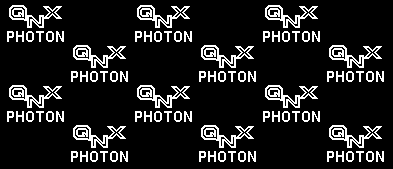Draw a bitmap several times
int PgDrawRepBitmap( void const *ptr,
int flags,
PhPoint_t const *pos,
PhPoint_t const *size,
int bpl,
PhPoint_t const *rep,
PhPoint_t const *space,
long tag );
int PgDrawRepBitmapmx( void const *ptr,
int flags,
PhPoint_t const *pos,
PhPoint_t const *size,
int bpl,
PhPoint_t const *rep,
PhPoint_t const *space,
long tag );
These functions build a command in the draw buffer to repeatedly draw the bitmap pointed to by ptr. For an explanation of bitmaps, see PgDrawBitmap().
These functions:
If you OR flags with Pg_REPBM_ALTERNATE, all the bitmaps are drawn twice; the second time the position is offset by half of space.x and space.y.
The bpl argument indicates the number of bytes per line of image data (that is, the offset from one line of data to the next). To calculate the size of the data transferred to the graphics driver, multiply bpl by size.y. You can determine the size and bpl arguments with the value returned by PxLoadImage().
The data pointed to by ptr is one bit per pixel. If the pixel value is 1, the pixel is drawn with the color set by PgSetTextColor() or PgSetTextDither(). If the pixel value is 0, the pixel is drawn as transparent unless you've set flags to Pg_BACK_FILL. With Pg_BACK_FILL, the pixel is drawn with the color set by PgSetFillColor() or PgSetFillDither(). The pixels are drawn most significant bit first.
The tag argument is used for data caching by programs such as phrelay. To calculate the tag, use PxCRC(). This argument is ignored if you set it to 0.
 |
If you call the "mx" form of this function, the data isn't
physically copied into the draw buffer. Instead, a pointer
to the bitmap is stored until the draw buffer is flushed.
Make sure you call PgFlush()
before you modify the bitmap.
If the data is in shared memory, the mx form of this function automatically passes a shared memory reference instead of the bitmap. |
The following example:
DrawRepBitmap() {
PhPoint_t p = { -32, -32 };
PhPoint_t rep = { 5, 3 };
PgSetTextColor( Pg_WHITE );
PgDrawRepBitmap( TestBitmap, 0, &p,
&TestBitmapSize, TestBitmapBPL,
&rep, &TestBitmapSize, 0 );
}
draws:

The following example:
DrawAltRepBitmap() {
PhPoint_t p = { 0, 0 };
PhPoint_t rep = { 3, 2 };
PhPoint_t space;
space.x = TestBitmapSize.x * 2;
space.y = TestBitmapSize.y * 2;
PgSetTextColor( Pg_WHITE );
PgDrawRepBitmap( TestBitmap, Pg_REPBM_ALTERNATE, &p,
&TestBitmapSize, TestBitmapBPL,
&rep, &space, 0 );
}
draws:

Photon
| Safety: | |
|---|---|
| Interrupt handler | No |
| Signal handler | No |
| Thread | No |
PgDrawBitmap(), PgDrawRepImage(), PgDrawRepImagemx(), PgFlush(), PgSetFillColor(), PgSetFillDither(), PgSetTextColor(), PgSetTextDither(), PxCRC(), PxLoadImage()